OpenRailwayMap/Work Rules in North America
Operating Rulebooks
This page contains information on the various common operating rulebooks in Canada, Mexico, and the US, in order to help complete the workrules=* tag. This data is very much a work in progress.
Definitive OpenRailwayMap (ORM) tagging conventions are found at OpenRailwayMap/Tagging. For general guidance on tagging specific to North American railroads, see OpenRailwayMap/Tagging in North America. For general information on the US railway mapping effort, see United States/Railroads, which contains some information also useful in Canada and Mexico.
NORAC
The Northeast Operating Rules Advisory Committee is both a rulebook and the organization that defines said rulebook. NORAC was formed in 1985 to create a common rulebook for the Northeast; operations became more complicated after the creation of Amtrak and Conrail, and after state and municipal agencies took over commuter rail operation and ownership. As such, NORAC has more ways to represent the same signal rule than any other set of operating rules in the United States. NORAC is a speed signalling system, and has the most speed signalling than any other rulebook. Those using NORAC have to use the rulebook in its entirety, with no additional rules.
workrules=US:NORAC
Member Railroads
Members and Membership Status| Railroad Name | Abbreviation | Reporting Mark(s) | Membership Status | Passenger | Freight | Applicable Lines | Notes |
|---|---|---|---|---|---|---|---|
| Adirondack Scenic Railroad | fixme | fixme | Associate Member | Heritage/Tourist | fixme | fixme | |
| Amtrak | AMTK | Full Member | Passenger | No | Shore Line (New Haven to Boston) New York Terminal District Springfield Line (New Haven to Springfield) Philadelphia to Harrisburg Main Line (Keystone Corridor) New York Terminal District |
||
| Belfast and Moosehead Lake Railway | B&ML | BML | Associate Member | Heritage/Tourist | Rights to | Belfast and Moosehead Railroad | |
| Cape Cod Central Railroad | |||||||
| Cape May Seashore Lines | |||||||
| Claremont Concord Railroad | |||||||
| Columbia & Reading Railway | |||||||
| Finger Lakes Railway | FLGK | Associate Member | Heritage/Tourist | Common Carrier | fixme | ||
| Grafton & Upton Railroad Company | |||||||
| Housatonic Railroad | fixme | HRRC | |||||
| Maine Eastern Railroad | MERR | Associate Member | Heritage/Tourist | Common Carrier | Rockland Branch Lower Road |
||
| Massachusetts Bay Transit Authority | MBTA | MBTX | Full Member | Commuter | No | fixme | |
| Metro-North Railroad | fixme | fixme | Former Member | ||||
| Naugatuck Railroad | fixme | NAUG | Associate Member | Heritage/Tourist | fixme | fixme | |
| New Jersey Transit | NJT | NJTR | |||||
| New York, Susquehanna, and Western Railway | NYS&W | NYSW | Associate Member | No | Common Carrier | All | |
| Pan Am Railways | PAR | fixme | fixme Member | fixme | Common Carrier | fixme | |
| Providence and Worcester Railroad | P&W | PW | Full Member | Excursion | Common Carrier | fixme | |
| Southern Railroad of New Jersey | |||||||
| Seminole Gulf Railway | |||||||
| SMS Rail Service | |||||||
| Southeastern Pennsylvania Transportation Authority | SEPTA | SEPA | |||||
| Valley Railroad | VRR | VALE | Associate Member | Heritage/Tourist | Rights to | Valley Line | |
| Wellsboro & Corning Railroad | |||||||
| West Chester Railroad | |||||||
| Winimac Southern Railroad | |||||||
| Winnipesaukee Scenic Railroad | |||||||
Defined Terms
Signal System Types
<todo>
Speeds
| Name | Passenger | Freight | Notes |
|---|---|---|---|
| Normal Speed | The Maximum authorized speed. | ||
| Limited Speed | Not exceeding 45 MPH. | Not exceeding 40 MPH | |
| Medium Speed | Not exceeding 30 MPH | ||
| Slow Speed | Not exceeding 15 MPH | ||
| Restricted Speed | Not exceeding a speed that permits the movement to be stopped within 1/2 the range of vision short of any obstructions or signals requiring a stop. | ||
Operating Rules
Signalling Rules
Keyvalues are defined US-NORAC:<rule>, where the value of <rule> is defined in the table below.
| Rule | Name | Description | Notes | Signal Aspects | Pedestal/Dwarf Signal Aspects | Semaphore Aspects |
|---|---|---|---|---|---|---|
| 280a | Clear to Next Interlocking | Trains without operative cab signals must proceed on fixed signal indication, not exceeding 79 MPH, approaching next home signal prepared to stop. | ||||
| 280b | Approach Normal | Trains without operative cab signals must proceed on fixed signal indication not exceeding 79 MPH. | ||||
| 281 | Clear | Proceed not exceeding Normal Speed. |    |
|||
| 281a | Cab Speed | Proceed in accordance with cab signal indication. Reduce speed to not exceeding 60 MPH if Cab Speed cab signal is displayed without a signal speed, or if cab signals are not operative. | ||||
| 281b | Approach Limited | Proceed approaching the next signal at Limited Speed. | Yellow triangle marker is a fixed signal. |   |
||
| 281c | Limited Clear | Proceed at Limited Speed until entire train clears all interlocking or spring switches, then proceed at Normal Speed. | Yellow triangle marker is a fixed signal. |    |
||
| 282 | Approach Medium | Proceed approaching the next signal at Medium Speed. |    |
|||
| 282a | Advance Approach | Proceed prepared to stop at the second signal. Trains exceeding Limited Speed must begin reduction to Limited Speed as soon as engine passes the Advance Approach signal. | ||||
| 283 | Medium Clear | Proceed at Medium Speed until entire train clears all interlocking or spring switches, then proceed at Normal Speed. In CSS territory with fixed automatic block signals, trains not equipped with operative cab signals must approach the next signal at Medium Speed. |
    |
|||
| 283a | Medium Approach Medium | Proceed at Medium Speed until entire train clears all interlocking or spring switches, then approach the next signal at Medium Speed. Trains exceeding Medium Speed must begin reduction to Medium Speed as soon as the Medium Approach Medium signal is clearly visible. | ||||
| 284 | Approach Slow | Proceed approaching the next signal at Slow Speed. Trains exceeding Medium Speed must begin reduction to Medium Speed as soon as engine passes the Approach Slow signal. |    |
|||
| 285 | Approach | Proceed prepared to stop at the next signal. Trains exceeding Medium Speed must begin reduction to Medium Speed as soon as the engine passes the Approach signal. |   |
|||
| 286 | Medium Approach | Proceed prepared to stop at the next signal. Trains exceeding Medium Speed must begin reduction to Medium Speed as soon as the Medium Approach Signal is clearly visible. |     |
|||
| 287 | Slow Clear | Proceed at Slow Speed until entire train clears all interlocking or spring switches, then proceed at Normal Speed. In CSS territory with fixed signals, trains not equipped with operative cab signals must approach the next signal at Medium Speed once they have left interlocking limits. |
    |
|||
| 288 | Slow Approach | Proceed prepared to stop at the next signal. Slow Speed applies until entire train clears all interlocking or spring switches, then Medium Speed applies. |        |
|||
| 290 | Restricting | Proceed at Restricted Speed until the entire train has cleared all interlocking and spring switches (if signal is an interlocking or CP Signal) and the leading wheels have passed a more favorable fixed signal or entered non-signalled DCS territory. In CSS territory, trains with operative cab signals must not increase speed until the train has run one train length or 500 feet (whichever distance is greater), past a location where a more favorable cab signal was received. |
fixme |        |
||
| 291 | Stop and Proceed | Stop, then proceed at Restricted Speed until the entire train has cleared all interlocking and spring switches (if signal is an interlocking or CP signal) and the leading wheels have passed a more favorable fixed signal, or entered non-signalled DCS territory. In CSS territory, trains with operative cab signals must not increase their speed until they have run one train length or 500 feet (whichever distance is greater) past a location where a more favorable cab signal was received. Where a letter G (grade marker) or a letter R (restricting marker) is displayed in addition to a number plate as part of these aspects, freight trains may observe the signal as though Restricting, Rule 290, were displayed. |
   |
|||
| 292 | Stop Signal | Stop. |       |
|||
| 293 | Switch Closed Signal | Proceed. | ||||
| 293a | Switch Open Signal | Proceed prepared to stop short of open switches. | ||||
| 293b | Approach Clear | Proceed. | Does not convey block or track information. | |||
| 293c | Approach Restricting | Proceed prepared to stop at the next signal. Trains exceeding Medium Speed must begin reduction to Medium Speed as soon as the engine passes the Approach Restricting signal. | Does not convey block or track information. | |||
| 294 | Clear Slide Detector Signal | Proceed; slide detector not actuated. | ||||
| 294a | Slide Detector | Approach actuated slide detector prepared to stop short of obstruction. | ||||
| 296 | Approach Permanent Speed Limit Sign | Proceed prepared to operate at posted speed through permanent speed restriction. | In electrified territory, this sign will be mounted in the catenary system; in non-electrified territory, this sign will be mounted on an overhead bridge or pole approximately 12 feet above the top of the rail. | 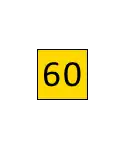 |
||
| 296a | Approach Speed Limit Sign | Approach the Speed Limit Sign at a speed not exceeding the speed posted on the Approach Speed Limit Sign. Where a sign with two sets of numerals is posted, the higher speed applies to passenger trains, and the lower speed applies to freight trains. |  |
|||
| 296b | Speed Limit Sign | Proceed at speed posted on the Approach Speed Limit Sign until the entire train has cleared the Resume Speed Sign. | 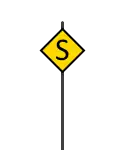 |
|||
| 296c | Resume Speed Sign | Resume speed after the entire train has passed the Resume Speed Sign. | 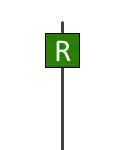 |
|||
| 296d | Diverging Approach Speed Limit Sign | If routed to affected track, approach the Speed Limit Sign not exceeding the speed on the Diverging Approach Speed Limit Sign. | 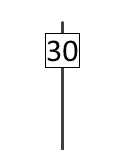 |
|||
| 297 | Approach Sign | Proceed prepared to stop at the Stop Sign. Trains exceeding Medium Speed must begin reduction to Medium Speed as soon as the engine passes the Approach Sign. | 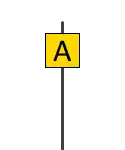 |
|||
| 297a | Stop Sign | Stop, unless permission is received as prescribed by Rule 135. | fixme |  |
||
| 297b | Working Limits Speed Limit Sign | Proceed not exceeding 30 MPH until passing a Working Limits Resume Speed Sign, unless otherwise instructed by the employee in charge. | fixme | 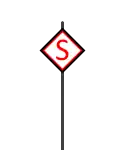 |
||
| 297c | Working Limits Resume Speed Sign | Resume speed after the entire train has passed the Working Limits Resume Speed Sign. |  |
|||
| 297d | Diverging Approach Sign | If routed to affected track, proceed prepared to stop at the Stop Sign. Trains exceeding must begin reduction to Medium Speed as soon as the engine passes the Diverging Approach Sign. | 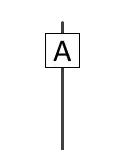 |
|||
| 298 | Distant Signal Marker | Visual reminder to push-pull trains that Rule 504(b) applies in the block governed by this signal. | Located on or near the mast of distant signals in territory where push-pull trains operate, cab signals are not in service, and the maximum speed of trains exceeds 30 MPH. | 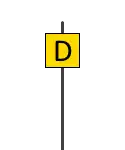 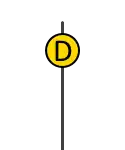 |
||
| 298a | Delayed in Block Sign | Visual reminder to push-pull trains that Rule 504(b) applies to station stops made at this station. | Located at or near the end of passenger stations in blocks between distant signals and home signals in territory where push-pull trains operate, cab signals are not in service, and the maximum speed of trains exceeds 30 MPH. | 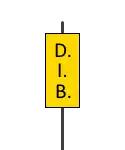  |
GCOR
The General Code of Operating Rules (GCOR) is a set of operating rules for railroads in the United States. The GCOR is used by Class I railroads west of the Chicago, most of the Class II railroads, and many Short-line railroads. The current version is the 7th Edition in effective April 1st, 2015.
workrules=US:GCOR
Member Railroads
Members and Membership Status| Railroad Name | Abbreviation | Reporting Mark(s) | Membership Status | Passenger | Freight | Applicable Lines | Notes |
|---|---|---|---|---|---|---|---|
| BNSF Railway | BNSF | BNSF, GN, BN, | Seventh Edition | Yes | Yes | All | |
| Union Pacific Railway | UP | UP, WP, SP, | Seventh Edition | Yes | Yes | All |
<membership table under construction>
CROR
The Canadian Rail Operating Rules (CROR) is a set of operating rules for railroads in Canada. The CROR is used by every Canadian railway. The current version is the one dated 9 May2022.
The CROR only dictates what light signals should look like, and leaves the track-side signs up to the individual operators. The signs are similar across the different operators
workrules=CA:CROR
Defined Terms
Speeds
| Name | Definition |
|---|---|
| Normal Speed | The Maximum authorized speed. |
| Limited Speed | Not exceeding 45 MPH. |
| Medium Speed | Not exceeding 30 MPH |
| Diverging Speed | Not exceeding 25 MPH |
| Slow Speed | Not exceeding 15 MPH |
| Turnout Speed | Unless otherwise provided by signal indication or special instructions, a speed not exceeding 15 MPH. |
| Restricted Speed | Not exceeding a speed that permits the movement to be stopped within 1/2 the range of vision short of any obstructions or signals requiring a stop. |
Signalling Rules
Keyvalues are defined CA-CROR:<rule>, where the value of <rule> is defined in the table below.
| Rule | Name | Description | Notes | Signal Aspects | Pedestal/Dwarf Signal Aspects |
|---|---|---|---|---|---|
| 405 | Clear Signal | Proceed | 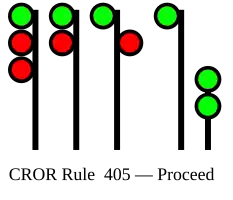 |
||
| 406 | Clear to Limited | Proceed, approaching next signal at LIMITED speed | 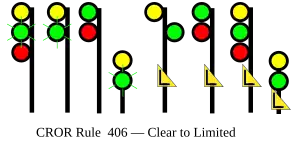
|
||
| 407 | Clear to Medium | Proceed, approaching next signal at MEDIUM speed | 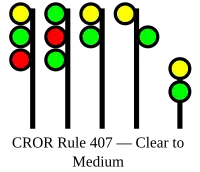 |
||
| 408 | Clear to Diverging | Proceed, approaching next signal at DIVERGING speed.
(DV plaque required) |
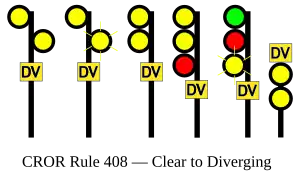
|
||
| 409 | Clear to Slow | Proceed, approaching next signal at SLOW speed. | 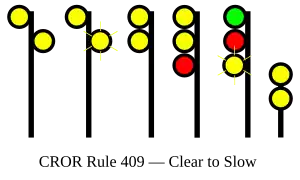
|
||
| 410 | Clear to Restricting | Proceed, next signal is displaying Restricting Signal. | 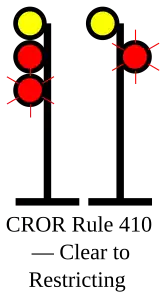 |
N/A | |
| 411 | Clear to Stop | Proceed, preparing to stop at next signal. | 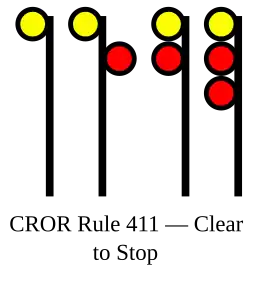
|
N/A | |
| 412 | Advance Clear to Limited | Proceed, approaching second signal at LIMITED speed. | 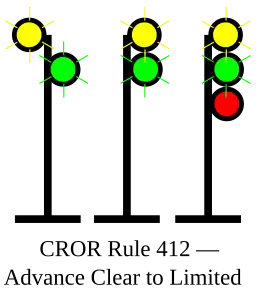
|
N/A | |
| 413 | Advance Clear to Medium | Proceed, approaching second signal at MEDIUM speed | 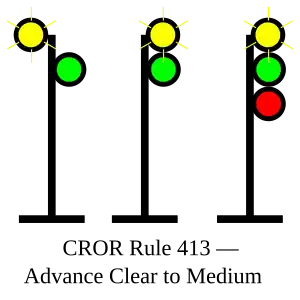
|
N/A | |
| 414 | Advance Clear to Slow | Proceed, approaching second signal at SLOW speed. | 
|
N/A | |
| 414A | Advance Clear to Diverging | Proceed, approaching second signal at DIVERGING speed. | 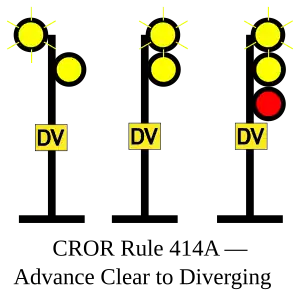
|
N/A | |
| 415 | Advance Clear to Stop | Proceed, next signal is displaying Clear to Stop, be prepared to stop at second signal. | 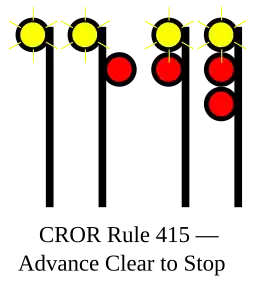
|
N/A | |
| 416 | Limited to Clear | Proceed, LIMITED speed passing signal and through turnouts. | 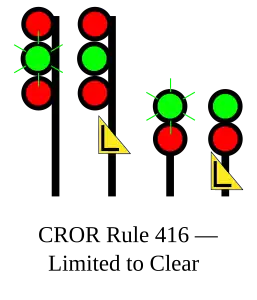
|
N/A | |
| 417 | Limited to Limited | Proceed, LIMITED speed passing signal and through turnouts, approaching next signal at LIMITED speed. |  |
N/A | |
| 418 | Limited to Medium | Proceed, LIMITED speed passing signal and through turnouts, approaching next signal at MEDIUM speed. |  |
N/A | |
| 419 | Limited to Slow | Proceed, LIMITED speed passing signal and through turnouts, approaching next signal at SLOW speed. | 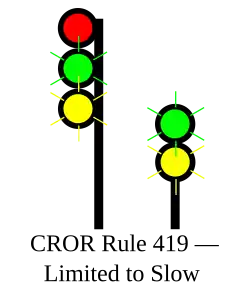
|
||
| 419A | Limited to Diverging | Proceed, LIMITED speed passing signal and through turnouts, approaching next signal at DIVERGING speed. | 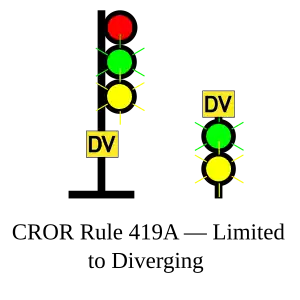
|
||
| 420 | Limited to Restricting | Proceed, LIMITED speed passing signal and through turnouts, next signal is displaying Restricting Signal. | 
|
||
| 421 | Limited to Stop | Proceed, LIMITED speed passing signal and through turnouts, preparing to stop at next signal. | 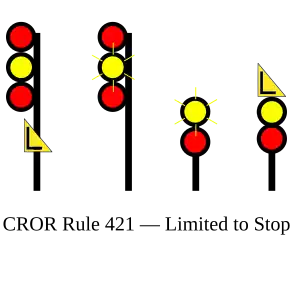
|
||
| 422 | Medium to Clear | Proceed, MEDIUM speed passing signal and through turnouts. | 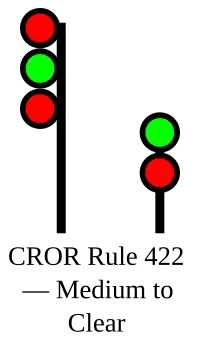 |
||
| 423 | Medium to Limited | Proceed, MEDIUM speed passing signal and through turnouts, approaching next signal at LIMITED speed. | 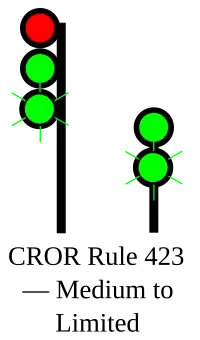 |
||
| 424 | Medium to Medium | Proceed, MEDIUM speed passing signal and through turnouts, approaching next signal at MEDIUM speed. |  |
N/A | |
| 425 | Medium to Slow | Proceed, MEDIUM speed passing signal and through turnouts, approaching next signal at SLOW speed. | 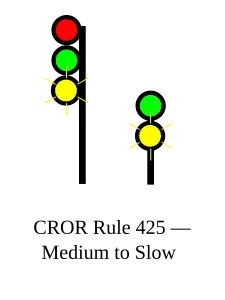
|
||
| 425A | Medium to Diverging | Proceed, MEDIUM speed passing signal and through turnouts, approaching next signal at DIVERGING speed.
(DV plaque required) |
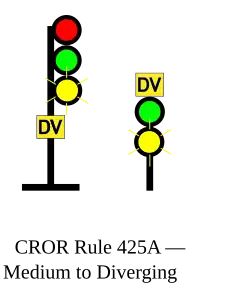 |
||
| 426 | Medium to Restrictinig | Proceed, MEDIUM speed passing signal and through turnouts, next signal is displaying Restricting Signal. | 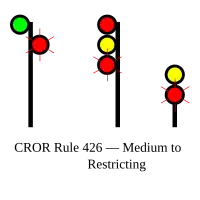 |
||
| 427 | Medium to Stop | Proceed, MEDIUM speed passing signal and through turnouts, preparing to stop at next signal |  |
||
| 428 | Diverging to Clear | Proceed, DIVERGING speed passing signal and through turnouts.
(DV plaque required) |
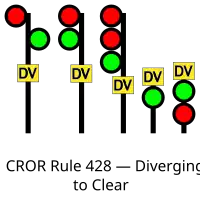 |
||
| 429 | Diverging to Stop | Proceed, DIVERGING speed passing signal and through turnouts preparing to stop at next signal.
(DV plaque required) |
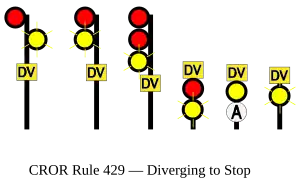
|
||
| 430 | Diverging | Proceed at REDUCED speed, not exceeding DIVERGING speed passing signal and through turnouts.
(DV plaque required) |
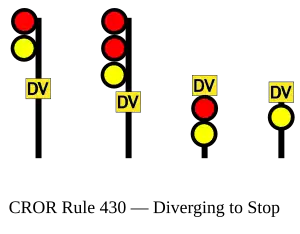
|
||
| 431 | Slow to Clear | Proceed, SLOW speed passing signal and through turnouts. | 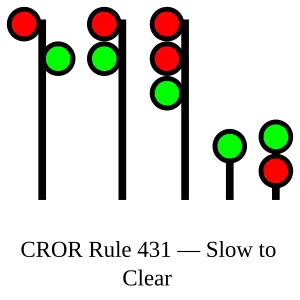
|
||
| 432 | Slow to Limited | Proceed, SLOW speed passing signal and through turnouts, approaching next signal at LIMITED speed |  |
||
| 432A | Diverging to Limited | Proceed, DIVERGING speed passing signal and through turnouts, approaching next signal at LIMITED speed.
(DV plaque required) |
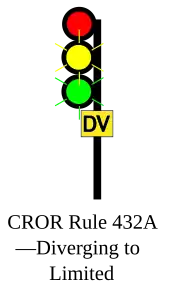 |
N/A | |
| 433 | Slow to Medium | Proceed, SLOW speed passing signal and through turnouts, approaching next signal at MEDIUM speed. | 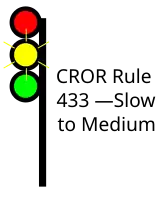 |
N/A | |
| 433A | Diverging to Medium | Proceed, DIVERGING speed passing signal and through turnouts, approaching next signal at MEDIUM speed.
(DV plaque required) |
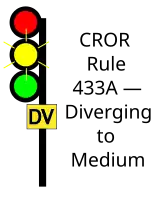 |
N/A | |
| 434 | Slow to Slow | Proceed, SLOW speed passing signal and through turnouts, approaching next signal at SLOW speed. | 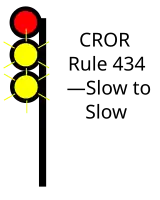 |
N/A | |
| 434A | Diverging to Diverging | Proceed, DIVERGING speed passing signal and through turnouts, approaching next signal at DIVERGING speed.
(DV plaque required) |
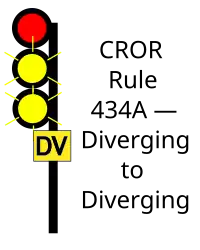 |
N/A | |
| 435 | Slow to Stop | Proceed, SLOW speed passing signal and through turnouts, preparing to stop at next signal. | 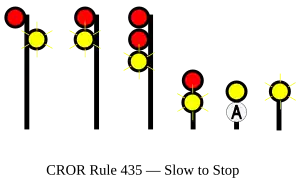
|
||
| 436 | Restricting Signal | Proceed at RESTRICTED speed. | 
|
||
| 437 | Stop and Proceed Signal | Stop, then proceed at RESTRICTED
speed. |

|
N/A | |
| 438 | Take/Leave Siding Signal | Indications will be specified in the Special Instructions for each specific application of this signal. | 
|
||
| 439 | Stop Signal | Stop.
(“A” plaque required, as shown) OPTIONAL PER RAILROAD: Unless required to clear a switch, crossing, controlled location, or spotting passenger equipment on station platforms, a train or engine not authorized by Rule 564 must stop at least 300 feet in advance of the STOP signal |
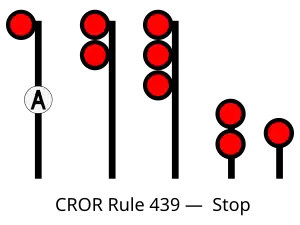
|
||
| 440 | Direction Indicator | Flashing arrow indicators attached to block signals when illuminated, identify that the route at the next controlled location is displaying a permissive signal and the route is lined and secured as indicated by the direction of the arrow. | 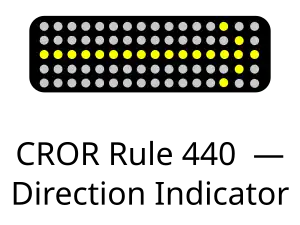
|
N/A |
Trackside signs
| Rule | Name | Description | Image |
|---|---|---|---|
| Whistle post | Located at least one-quarter (¼) mile from the edge of all public crossings at grade, blind curves and tunnels | 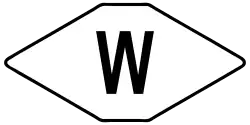  | |
| Prohibited Whistle Post | Located at least one-quarter (¼) mile from the edge of every public crossing at grade, where engine whistle signal Rule 14 (l) is prohibited by special instruction.
Sound whistle only in emergencies. |
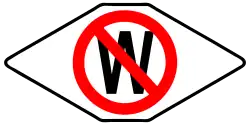 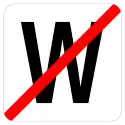 | |
| Main Track Ends | Located at the actual point where main track ends. | 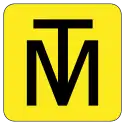 | |
| Permissible Speed sign | Marks the beginning of a speed zone specified in special instructions.
When one speed is shown on the sign, it applies to all trains and engines. When two speeds are shown on the sign, the higher speed applies to passenger trains and the lower speed to other trains and engines. If the new speed zone is faster than the current speed zone, the movement must clear the current speed zone before speeding up |
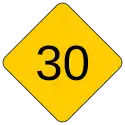  | |